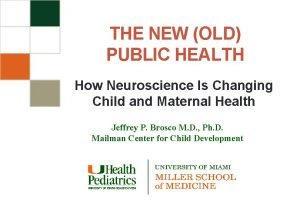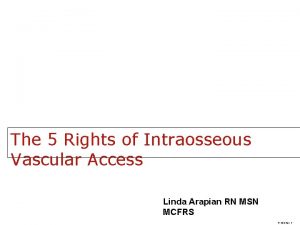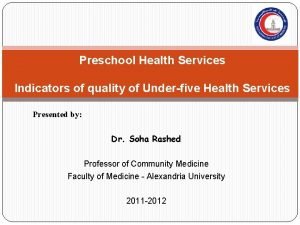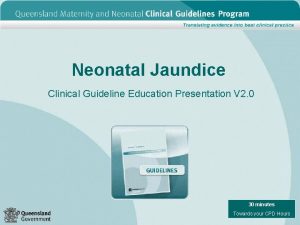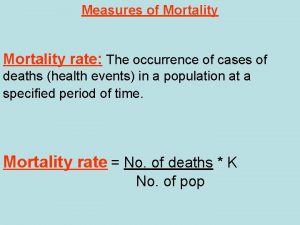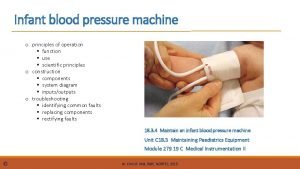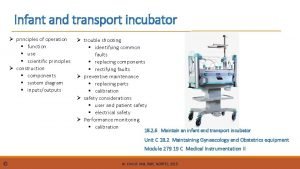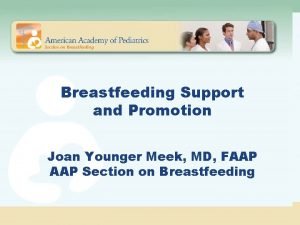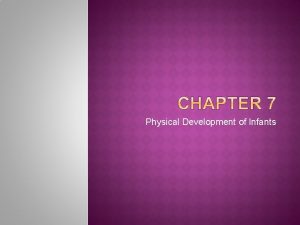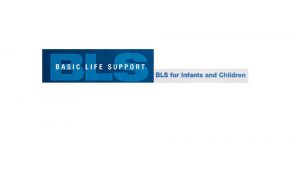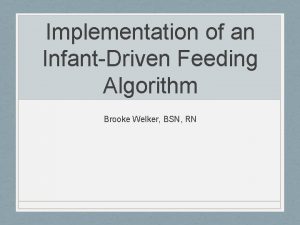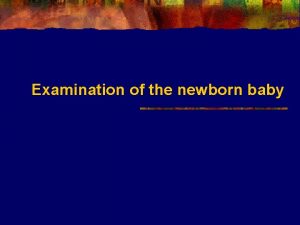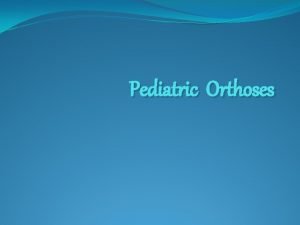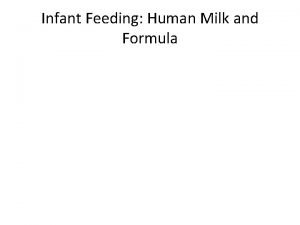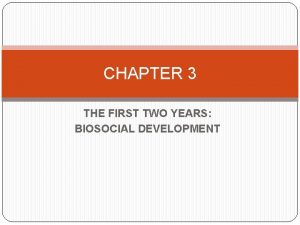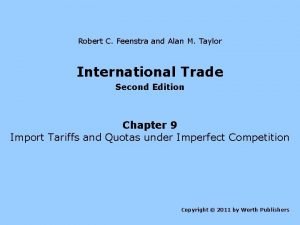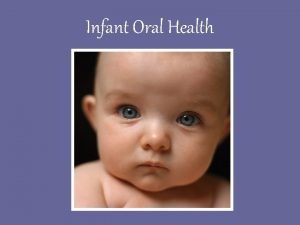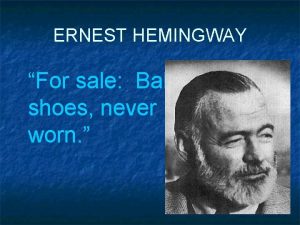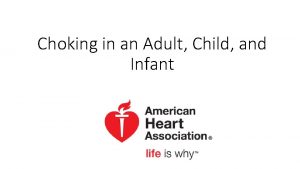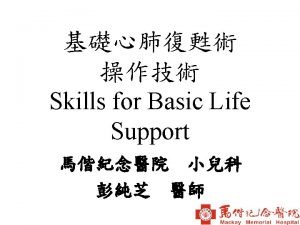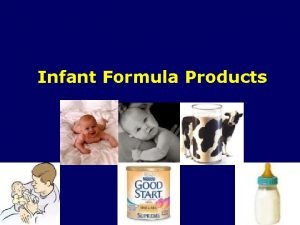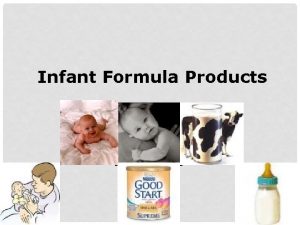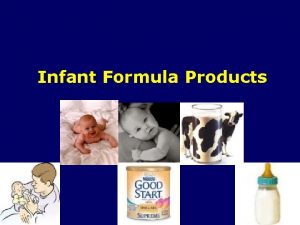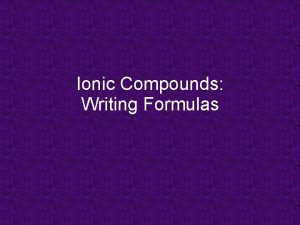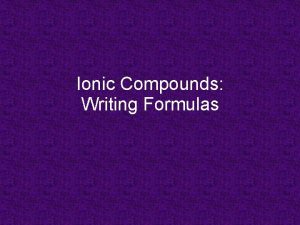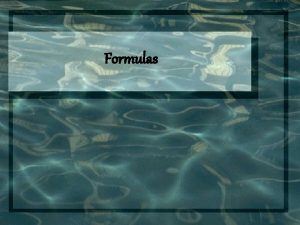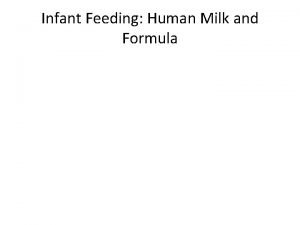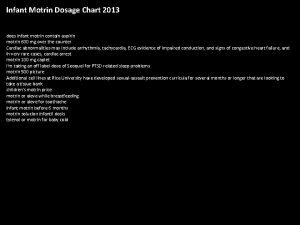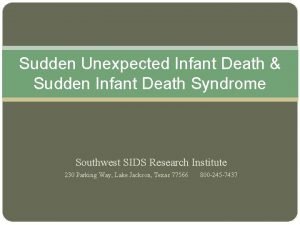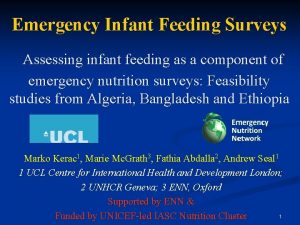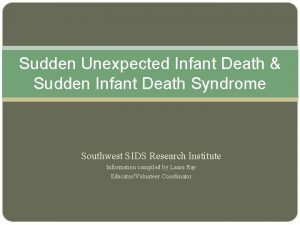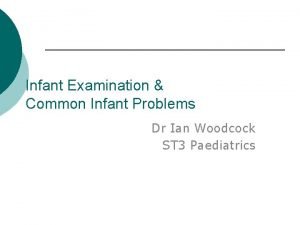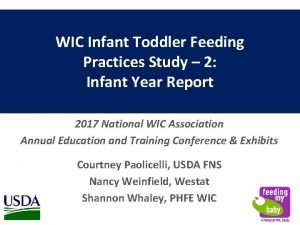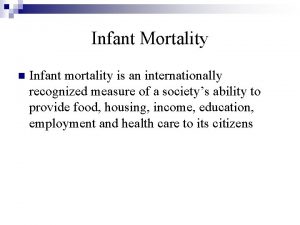Infant Formulas Whats for What and Whats for





















































- Slides: 53

Infant Formulas What’s for What and What’s for Whom? ? ? Kathryn Camp, MS, RD, CSP Pediatric Nutritionist Walter Reed Army Medical Center


Today’s Presentation History and regulation of infant formulas Categorize formulas by composition and intended use Alternate products sometimes given to infants

Infant Formula Product intended for use by infants that simulates human milk or is suitable as a complete or partial substitute for human milk

Historical Perspective Early attempts at artificial feeding of infants employed the milk of other mammals – Infant survival during the 1 st few weeks of life approached 0% Wet nurses were employed but their availability declined with the onset of the Industrial Revolution

Examples of Early Infant Feeding Vessels Pewter Ceramic

Commercial Formula Development In 1867, Henri Nestlé created the first commercially sold formula. Banana feeder

At the end of the 19 th century the gross composition of human milk was determined. Recognition of low concentration of protein in BM lead to the use of diluted cow milk – Less mortality among infants – But poor growth To increase caloric density of diluted cow milk, sugar or cereals were added – Infants lived and grew – Pediatrics became a medical specialty – Mortality still remained high


Early 20 th century – Electric refrigeration and pasteurization Significant decrease in mortality Increased popularity of formula feeding – Improved sanitation and milk handling – Modifications in cow protein improved digestibility – Direct advertising to physicians influenced use of formulas

– Good rubber nipples made feeding easier

1911 -- Dextri-Maltose introduced by Mead Johnson 1915 -- a formula called synthetic milk adapted (forerunner of Wyeth’s SMA) required only the addition of water – 67 kcal/d. L – Non-fat cow milk – Lactose – Oleo and vegetable fat

The importance of vitamins was recognized – Infant formulas became suitable vehicles – Previously common vitamin-deficiency diseases such as scurvy and rickets became less prevalent

Highlights in Formula History 1929 --the first soy flour formula was developed – milk–free, lactose–free – designed as an alternative to the home prepared milk–based formulas of the time – soy flour caused significant abd discomfort 1942 --protein hydrolysate formula 1959—iron-fortified formula appeared 1960—appreciation of renal solute load 1965 --soy protein isolate formula

1966— 1 st premmie formula designed to meet the special nutritional needs of rapidly growing low–birth–weight infants. 1971 --first nutritionally complete protein hydrolysate formula containing MCT oil. 1990’s – lactose free cow milk-based formulas appeared – Nucleotides were added to some formulas Early 2000’s – DHA and ARA were added to both cow milk and soy formulas

Regulation of Infant Formulas The US was one of the last major industrialized nation to implement federal regulations concerning safety of infant formulas The first FDA reference to safety of infant formulas was in 1938 1941 first requirement for specific information to be included on an infant formula label No new revisions until 1971 when the results of AAP recommendations and public hearings included minimum requirements for protein, fat, linoleic acid and 17 vitamins and minerals.

Infant Formula Act Passed by Congress in 1980 Following reports in 1979 that over 100 infants became seriously ill because of the lack of chloride in two soy-based formulas The new law authorized the FDA to adjust nutritional standards for infant foods to conform with the best available scientific knowledge. Manufacturers are required to test their products periodically and report to the FDA when they do not meet the official specs.

Furthermore…. Formula Manufacturers are required to Verify composition before a new product goes to market – specifying that it meets minimum (29 nutrients) and does not exceed maximum (9 nutrients) requirements Meet “good manufacturing practices” Maintain records for annual inspection The FDA has the authority to recall products that are adulterated or misbranded

Categories of Infant formulas Standard – Similac, Enfamil, Carnation, Store brands Soy – Isomil, Prosobee, Alsoy, Protein hydrolysates – Pregestimil, Nutramigen, Alimentum Elemental – Neocate, Elecare Premature – Enfacare, Neo. Sure “Next Step”—older infants and toddlers Specialized – Modified for specific medical indication Metabolic, renal, GI disorders

Standard Formulas Cow milk altered by – – – Removing the butter fat Adding vegetable oils and carbohydrate Decreasing the protein 34 g/L to 15 g/L – Adding vitamins, minerals, and other nutrients such as amino acids, fatty acids, nucleotides Whey to casein ratio varies – – Major whey protein is β-lactoglobulin Major casein protein is bovine -casein Amino acid profile varies Taurine and carnitine are added to some


Whey to Casein Ratio Breast milk % Whey % Casein 70 30 β-casein -lactalbumin, lactoferrin, Ig. A Enfamil 60 40 Similac 18 82 Carnation Good Start Soy 100 0

Standard Formula Features Breast milk – – – – 20 cal/oz Human milk fat Lactose whey: casein 70: 30 9 g/L Iron 0. 3 mg/L Vitamin D 21 IU/L 260 m. Osm/kg H 20 Contains DHA and AA Enfamil/Similac/Good Start – – – – 20 cal/oz Soy, coconut, sunflower, palm Lactose 60: 40, 18: 82 15 g/L Iron 12 mg/L Vitamin D 405 IU/L 265 -300 m. Osm/kg H 20 DHA and AA added Formulas still made without

Standard Formula Features Breast milk – – – – 20 cal/oz Human milk fat Lactose whey: casein 70: 30 9 g/L Iron 0. 3 mg/L Vitamin D 21 IU/L 260 m. Osm/kg H 20 Contains DHA and AA Enfamil/Similac/Good Start – – – – 20 cal/oz Soy, coconut, sunflower, palm Lactose 60: 40, 18: 82 15 g/L Iron 12 mg/L Vitamin D 405 IU/L 300 m. Osm/kg H 20 DHA and AA added Formulas still made without

Low Iron Formula PEDIATRICS Vol. 104 No. 1 July 1999, pp. 119 -123 AMERICAN ACADEMY OF PEDIATRICS: Iron Fortification of Infant Formulas Position Statement “The manufacture of formulas with iron concentrations less than 4. 0 mg/L should be discontinued. If these formulas continue to be made, low-iron formulas should be prominently labeled as potentially nutritionally inadequate with a warning specifying the risk of iron deficiency. These formulas should not be used to treat colic, constipation, cramps, or gastroesophageal reflux. ”

Soy Formulas Indications for use – Milk protein intolerance (IGE mediated) – Lactose intolerance (rare) – Galactosemia – Vegetarian diet Not appropriate for – preterm infants < 1800 grams d/t risk of osteopenia and growth concerns – Hereditary fructose intolerance (contains sucrose)

Soy Formulas Breast milk – – – – 20 cal/oz Human milk fat Lactose whey: casein 70: 30 9 g/L Iron 0. 3 mg/L Vitamin D 21 IU/L 260 m. Osm/kg H 20 Contains DHA and AA Isomil/Prosobee – 20 cal/oz – palm olein, soy, coconut, sunflower – Corn syrup/sucrose – Protein, 17 g/L soy isolate and L-MET – Iron 12 mg/L – Vitamin D 405 IU/L – 200 m. Osm/kg H 20 – DHA and AA added

Protein Hydrolysates Hydrolyzed casein or whey protein Various fat blends All are lactose free

Protein Hydrolysates Breast milk – – – – 20 cal/oz Human milk fat Lactose 70%whey 30%casein 9 g/L Iron 0. 3 mg/L Vit D 21 IU/L 260 m. Osm/kg H 20 Contains DHA and AA Pregestimil – – – – 20 cal/oz MCT (55%), safflower, soy corn syrup solids, corn starch Casein Hydrolysatenonantigenic peptides 19 g/L Iron 12 mg/L Vitamin D 405 IU/L 330 m. Oms/kg H 20 Does not have DHA and AA

Other Hydrolysates Alimentum Advance – For infants and children with severe food allergies, sensitivity to intact protein (including colic symptoms due to protein sensitivity), protein maldigestion or fat malabsorption – Hydrolyzed casein + free amino acids – 33% of fat is MCT – 370 m. Oms/kg H 20 – Contains DHA and ARA – Lactose free (contains sucrose) Nutramigen LIPIL – – hypoallergenic for infants who are sensitive to intact protein in milk and soy-based formulas – 270 m. Oms/kg H 20 – Lactose and sucrose free

New Kid on the Block!

Enfamil Gentlease LIPIL – Launched in July 05 – “is a nutritionally balanced, milk-based infant formula designed as a first switch formula for babies who have fussiness or gas. ” – Partially broken down proteins 6 -9% hydrolyzed – Reduced lactose 1/4 of typical – Whey: casein ratio of 60: 40 – Contains DHA and ARA, “nutrients also found in breast milk that promote brain and eye development. ” – No studies to document efficacy in the intended population

Elemental Formulas Indications: For infants and children who need an amino acid-based medical food or who cannot tolerate intact protein – protein maldigestion or malabsorption Short bowel syndrome – severe or multiple food allergies – GI tract impairment eosinophilic esophagitis or gastroenteritis – Lactose, sucrose, fructose, and galactose-free Galactosemia and hereditary fructose intolerance

Element al 5% MCT Breast milk – – – – 20 cal/oz Human milk fat Lactose 70%whey 30%casein 9 g/L Iron 0. 3 mg/L Vit D 21 IU/L 260 m. Osm/kg H 20 Contains DHA and AA 33% MCT Neocate/Elecare – – – – 20 cal/oz MCT, safflower, soy Corn syrup solids 100% free amino acids, 21 g/L Iron 12 mg/L Vitamin D 500 IU/L 335 m. Osm/kg H 20 Do not contain DHA and AA

Premature Formulas NICU – Similac Special Care Enfamil Premature Lipil 20 and 24 kcal/oz Available only for inpatients Cow milk based 40% of fat is MCT Products are not appropriate for larger babies (2. 5 -3 kg) because of higher amounts of vitamins (esp A and D) and minerals

Premature Infants Hospital discharge – Neo. Sure – Enfa. Care 22 kcal/oz Pro, calcium, phosphorus, MCT (20%) Cow milk based Improved growth – Wheeler, RE. Journal of Perinatology, 16: 111 -116, 1996.

Others Enfamil AR – Milk-based standard formula – added rice starch that thickens in the acid environment of the stomach – For babies who spit up frequently or need a thickened formula – Reduced reflux symptoms Vanderhoof , Clin Pediatr. 2003; 42: 483 -495. Isomil DF – – Soy protein, soy fiber For firming loose, watery stools in infants older than 6 months and toddlers. – duration of antibiotic-induced diarrhea Burks, J Pediatr. 2001; 139(4): 578

Others Enfamil Lacto. Free – Milk-based – Lactose and sucrose-free formula for infants with fussiness, gas or diarrhea due to lactose sensitivity. – Calcium absorption was less than with lactose containing formula but total calcium absorption was adequate (Abrams, AJCN; 2002) – Studies on efficacy have been mixed

Generic Formulas Must meet requirements set under the infant formula act – Minimums and maximums Less expensive

Specialized Portagen (Mead Johnson) – 86% MCT oil fat malabsorption, intestinal lymphatic obstruction, or chylothorax – 2002 recall after the death of a premature infant from Enterbacter sakazakii contaminated formula. – Manufacturer no longer recommends for infants RCF (Ross) Ross Carbohydrate Free – Infants with CHO intolerance – Must add CHO – Modified for the ketogenic diet

Specialized, cont: Similac PM 60/40 – For infants with hypocalcemia due to hyperphosphatemia or impaired renal function. Metabolic Formulas – PKU, MSUD, tyrosinemia, homocystinuria, glutaric aciduria, PPA/MMA, urea cycle – Ross, Mead Johnson, Scientific Hospital Supplies

Toddler Formulas Milk and soy based products for infants and toddlers – 9 -24 months – who are eating solid foods Contain DHA and ARA Has > twice the calcium of regular infant formulas (300 mg vs 125 mg)


Alternatives to Infant Formulas Evaporated Milk Formula – AAP does not support its use Poorly digested fat Low iron and vitamin C Excessive sodium, protein, PO 4 – Preferable to unmodified cow milk – Recipe 13 oz can 19. 5 oz water 3 Tablespoons sugar or corn syrup – Requires supplementation with vitamins A, D, calcium, and iron


10. 5 mo old female with hx of poor growth – 26. 5 weeks gestation – 3 mo NICU course complicated by poor feeding, BPD, hernia repair, seizures Discharged on Elecare and O 2 7. 5 mo corrected age – Meds—synthroid, zantac, Poly-vi-sol, flovent, calcium gluconate Case

Weight--5 kg Length-- 61. 6 cm IBW--6. 5 kg 77% of IBW

Dietary data – Family had switched to goat milk 1 mo prior on the advice of “someone” who said it would provide more nutrition – She was drinking more volume – 1 pound weight loss in 1 month 24 -hr dietary intake – 20 oz of goat milk (rice cereal added at 1 T per 4 oz) – 3 T baby solids

Dietary Analysis Actual Needed Calories 425 (85/kg) 650 min Protein 22 (4. 4/kg) 15 -18 Cal dist: For 6 -12 mo Protein 20 15 CHO 30 45 -55 Fat 50 35 -45

Formulas vs Goat Milk Nutrient/8 oz Calories Protein, g CHO, g Fat, g Sodium, mg Iron, mg Vitamin C, mg Folate, μg Vitamin D, IU Osmolality *Added Neo. Sure 180 4. 6 (10%) 18. 5 (41%) 9. 8 (49%) 41 2. 2 18 31 86 224 Goat Milk 140 8 (23%) 11 (31%) 7 (46%) 115 0 0 80 * 100 * 339 Elecare 180 5. 3 (14%) 19 (43%) 8. 5 (43%) 81 3. 2 16 53 77 330

Choose the appropriate formula: Infant with galactosemia – Isomil, Prosobee, Pregestimil, Neocate, Elecare Infant with multiple food allergies – Hydrolysate then Neocate, Elecare Healthy term infant – Enfamil or Similac Infant with decreased pancreatic lipase and bile salts – Portagen Infant with renal fx and electrolytes – Similac PM 60/40

Resources Infant Formula: Evaluating the Safety of New Ingredients (2004) Food and Nutrition Board, Institute of Medicine – http: //www. nap. edu/openbook/0309091500/html/ Infant Feedings: Guidelines for Preparation of Formula and Breastmilk in Health Care Facilities. Robbins and Beker (eds), ADA 2003 – http: //www. eatright. org/Public/Product. Catalog/Search able. Products/104_8515. cfm

The End!
 Pregnancy and infant cohort monitoring and evaluation
Pregnancy and infant cohort monitoring and evaluation Keeping an infant safe and well section 7-3
Keeping an infant safe and well section 7-3 Kenmore park infant and nursery school
Kenmore park infant and nursery school Keeping an infant safe and well section 7-3
Keeping an infant safe and well section 7-3 Saguaro infant care and preschool
Saguaro infant care and preschool Sparhawk infant school
Sparhawk infant school Infant child and adolescent berk 8th edition chapter 1
Infant child and adolescent berk 8th edition chapter 1 Brigance test for 2 year old
Brigance test for 2 year old Jama 2017
Jama 2017 Hart plain infant school
Hart plain infant school Drdp modified essential view
Drdp modified essential view Infant-industry argument
Infant-industry argument Counter clockwise
Counter clockwise Imr equation
Imr equation Infant compression to ventilation ratio
Infant compression to ventilation ratio What is 90 degree angle for injection
What is 90 degree angle for injection Nips pain scale
Nips pain scale Jaundice chart 37 weeks
Jaundice chart 37 weeks Death rate formula
Death rate formula Baby reflexes chart
Baby reflexes chart Module 45 developmental issues
Module 45 developmental issues Juan soriano la niña muerta; the dead girl; dead infant
Juan soriano la niña muerta; the dead girl; dead infant Infant reflexes chart
Infant reflexes chart Infant blood pressure
Infant blood pressure Infant incubator working principle pdf
Infant incubator working principle pdf Infant botulism
Infant botulism Llf in first aid
Llf in first aid Convent of the holy infant jesus school
Convent of the holy infant jesus school Infant personality development
Infant personality development Weight gain in infant
Weight gain in infant Chest compression for infant 2 rescuer
Chest compression for infant 2 rescuer Growth refers to
Growth refers to Objective of cpr
Objective of cpr Infant-driven feeding scale
Infant-driven feeding scale Femoral pulse in child
Femoral pulse in child Dormers wells infant school
Dormers wells infant school Woodfield infant school
Woodfield infant school Papoose infant spinal immobilizer
Papoose infant spinal immobilizer Isomil df
Isomil df Infant/toddler sensory profile score sheet
Infant/toddler sensory profile score sheet Embrace infant warmer
Embrace infant warmer Social impulses foster infant language
Social impulses foster infant language Social impulses foster infant language
Social impulses foster infant language Phoenix infant academy
Phoenix infant academy Walter infant school
Walter infant school Wood street infant school
Wood street infant school Infant mortality rate formula
Infant mortality rate formula Infant industry
Infant industry Infant
Infant Downs view infant school
Downs view infant school Ernest hemingway shoes
Ernest hemingway shoes Infant
Infant Infant age
Infant age Pallor cyanosis
Pallor cyanosis








